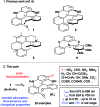Functionalized cationic [4]helicenes with unique tuning of absorption, fluorescence and chiroptical properties up to the far-red range
- PMID: 29348909
- PMCID: PMC5772034
- DOI: 10.1039/c6sc00614k
Functionalized cationic [4]helicenes with unique tuning of absorption, fluorescence and chiroptical properties up to the far-red range
Abstract
Unprecedented regioselective post-functionalization of racemic and enantiopure cationic diaza [4]helicenes is afforded. The peripheral auxochrome substituents allow a general tuning of the electrochemical, photophysical and chiroptical properties of the helical dyes (26 examples). For instance, electronic absorption and circular dichroism are modulated from the orange to near-infrared spectral range (575-750 nm), fluorescence quantum efficiency is enhanced up to 0.55 (631 nm) and circularly polarized luminescence is recorded in the red (|glum| ∼ 10-3).
Figures









References
-
- Phillips K. E. S., Katz T. J., Jockusch S., Lovinger A. J., Turro N. J. J. Am. Chem. Soc. 2001;123:11899–11907. - PubMed
- Field J. E., Muller G., Riehl J. P., Venkataraman D. J. Am. Chem. Soc. 2003;125:11808–11809. - PubMed
- Hassey R., Swain E. J., Hammer N. I., Venkataraman D., Barnes M. D. Science. 2006;314:1437–1439. - PubMed
- Kaseyama T., Furumi S., Zhang X., Tanaka K., Takeuchi M. Angew. Chem., Int. Ed. 2011;50:3684–3687. - PubMed
- Nakamura K., Furumi S., Takeuchi M., Shibuya T., Tanaka K. J. Am. Chem. Soc. 2014;136:5555–5558. - PubMed
-
- Morrison D. J., Trefz T. K., Piers W. E., McDonald R., Parvez M. J. Org. Chem. 2005;70:5309–5312. - PubMed
- Oyama H., Nakano K., Harada T., Kuroda R., Naito M., Nobusawa K., Nozaki K. Org. Lett. 2013;15:2104–2107. - PubMed
- Shi L., Liu Z., Dong G., Duan L., Qiu Y., Jia J., Guo W., Zhao D., Cui D., Tao X. Chem.–Eur. J. 2012;18:8092–8099. - PubMed
- Hua W., Liu Z., Duan L., Dong G., Qiu Y., Zhang B., Cui D., Tao X., Cheng N., Liu Y. RSC Adv. 2015;5:75–84.
-
- Latterini L., Galletti E., Passeri R., Barbafina A., Urbanelli L., Emiliani C., Elisei F., Fontana F., Mele A., Caronna T. J. Photochem. Photobiol., A. 2011;222:307–313.
- Li M., Feng L.-H., Lu H.-Y., Wang S., Chen C.-F. Adv. Funct. Mater. 2014;24:4405–4412.
Grants and funding
LinkOut - more resources
Full Text Sources
Other Literature Sources
Miscellaneous

